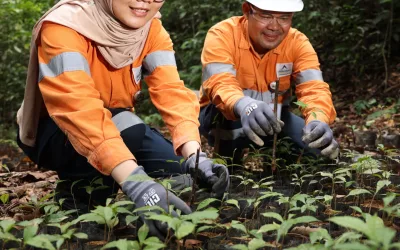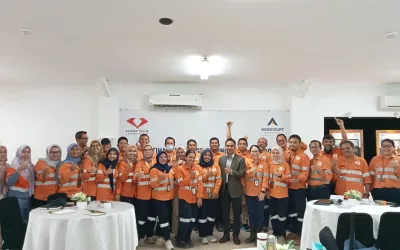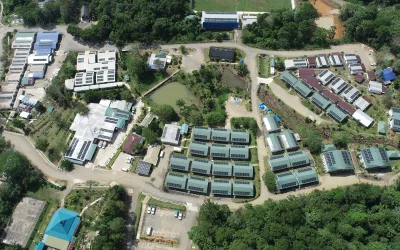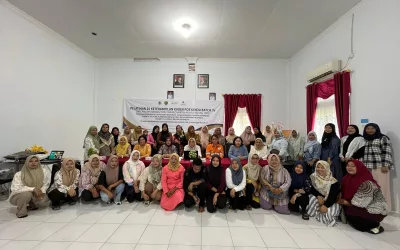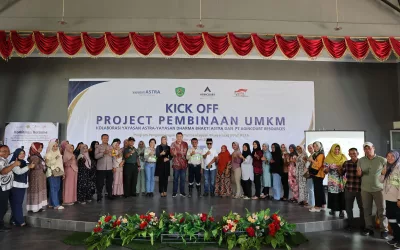Just less than 30 kilometers on the North East side of the Martabe gold mine, lies a tranquil and peaceful forest known as the Batangtoru, which is also referred to as “Harangan Tapanuli” by the local people, a tropical forest ecosystem spanning 240,985 hectares from lowlands, hills to mountains. This forest is a shelter and a place to find food for 20 species of protected mammals and 251 species of birds. There are more than 1000 species of plants in this forest, 8 of which are endangered and 3 species are endemic to Sumatra. The high biodiversity in Batangtoru plays an important role in supporting the lives of people living around the forest.
The forest, which is also a source of water flowing through the Batangtoru River, is one of the biggest concerns of PT Agincourt Resources to protect and preserve the biodiversity in the Batangtoru forest. Exploring the Batangtoru Forest is like stepping into another world untouched by time and humans. The sights, sounds, and smells of this enchanting place transport visitors to a realm where nature reigns. Every step reveals new wonders, new species waiting to be discovered.
As the sun sets over the forest, casting a golden glow on its ancient trees, one can’t help but admire the intricate web of life that thrives within its borders. Whistling and chirping sounds come not only from birds but also from primates such as gibbons and orangutans who call out as a way of communicating. Batangtoru Forest is a nature reserve for the extraordinary that must be maintained and protected.
Rainfall falls very high in the Batangtoru ecosystem which has varying elevations; the lowest point is 133 masl with most of the forest above 850 masl and the highest point is 1909 masl. Batangtoru has enormous wealth and biodiversity and it is estimated that there are around 300 different species in every hectare. The Batangtoru area is one of the most important protected forests in Sumatra and is also home to notable mammal species including the critically endangered Tapanuli Orangutan (Pongo Tapanuliensis), the new mascot of Batangtoru because this species is only found in Batangtoru, the Sumatran tiger, and the Sumatran tapir. Batangtoru is the only forest in Sumatra where these three species coexist!
Forest With Abundant Forage Trees
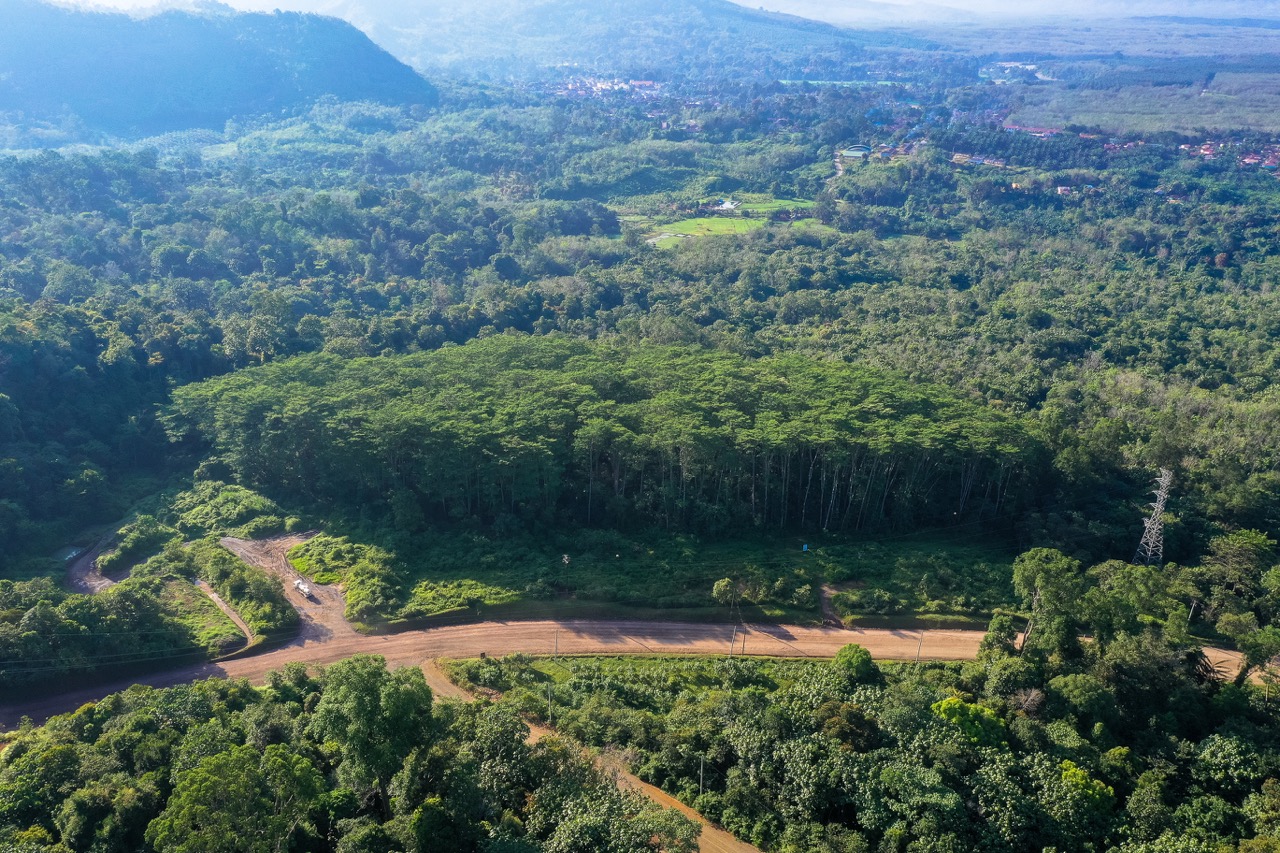
Based on research by the Bogor Agricultural Institute in 2008, the Batangtoru forest is dominated by trees with a diameter of 10-30 cm and grows to a maximum height of 30 meters from the ground. The high biodiversity of vegetation in the Batangtoru forest also provides food trees for the Tapanuli Orangutan and other species. Forage trees with a diameter of 10-30 cm and a height of 10-30 m are abundant in the Batangtoru forest, especially in the moist old secondary forest.
The most prominent forage tree species is Madhuca sp. (local name: sapot), Lithocarpus conocarpa (hoteng), Castanopsis sp. (Andihit), Podocarpus imbricatus (Sampinur flower), Litsea firma (three veins), and Garcinia bancana (hollow horn). Owa (Hylobates agilis) and gibbon (Symphalangus syndactylus) are two types of hylobatidae species that inhabit the forests of Sumatra. One of the forest areas in Sumatra which is sympatrically inhabited by two types of Hylobatidae is the western Batangtoru Forest, North Sumatra Province. Gibbons are arboreal primates that live exclusively in the forest canopy, and they are highly dependent on the vegetation conditions of their habitat.
Read Also: Commemorating Indonesian Tree Planting Day, PTAR Engages People to Care for the Environment
The forest which is the habitat of the Tapanuli orangutan which is isolated from the Acehnese orangutan (Pongo Abelii) population in the northern part of Sumatra (Gunung Leuser Ecosystem) is still experiencing habitat degradation at an average of 2% per year due to forest logging. It is estimated that the rate of degradation of this habitat will be higher in the future, thus accelerating the population decline and leading to the extinction of the Tapanuli orangutan. With this in mind, the western part of the Batangtoru forest area was also designated as one of the seven main targets for the Tapanuli orangutan conservation effort, so that the government and all related parties will continue to carry out conservation action efforts by involving the local community.
When it started operating, the Martabe gold mine was outside the boundaries of the Batangtoru Main Biodiversity Area (KBA). However, the KBA boundaries have since been expanded, causing a small portion of the mine’s operating area to overlap with the KBA boundaries. PTAR, which prioritizes biological conservation, continuously works with related parties to anticipate all potential changes in this limit by minimizing the impacts that may arise, including the possibility of the entry of protected endangered species into the mine area.
KBAs are officially recognized boundaries established in 2006 by a partnership of non-governmental conservation organizations, including IUCN, WWF, Wildlife Conservation Society, Rainforest Trust, Critical Ecosystem Partnership Fund, Global Wildlife Conservation, Global Environment Facility, Conservation International, BirdLife International, Conservation Birds of America, Amphibian Survival Alliance, and Royal Society for the Protection of Birds. As of January 2022, only 590 hectares of the Martabe gold mine area are actively used, with a small portion intersecting with the boundaries of the Batangtoru Ecosystem (BTE). The mine footprint covers 918 hectares, less than 0.25% of which overlaps with the total size of BTE.
PTAR is extremely diligent when it comes to managing the mining area, adhering to rigorous procedures that include assigning importance to the trees present in the area. To obtain the necessary permits, PTAR follows a multi-layered process, which includes Environmental Impact Assessment Studies (or AMDAL) that involve the active participation of communities, academics, and the government. Based on this process, PTAR clears land, but even then, they are careful to minimize the felling of trees. To dig samples from necessary land, regardless of the incurred cost, PTAR operates helicopters to save trees in the process.
By using a helicopter, very little land is cleared because the helicopter can pass through trees that don’t need to be cut down. Even though only a small amount of land is cleared, PTAR’s enviro department will immediately replant the land with new trees when it has been used up. This process has become a standard procedure and an integral part of all processes in mine management. PTAR employs sound mining procedures to minimize impacts on biodiversity associated with mines.
Having a knowledge about the abundance of biodiversity in the Batangtoru forest, the PTAR enviro department is working hard and establishing a cooperative relationship with North Sumatra’s BBKSDA in maintaining the sustainability of the ecosystem and is also involved in efforts to protect animals and or any other species that they think is on its way to extinction. Protecting biodiversity has always been one of PTAR’s core missions. In collaboration with the North Sumatra BBKSDA and related institutions, PTAR regularly provides training and counseling on the importance of protecting forests and biodiversity in Batangtoru.
PTAR is actively involved in patrols and society education initiated by the North Sumatra BBKSDA and NGOs. The patrol often takes subtle and persuasive approaches to residents who keep animals in their homes. PTAR several times provided support for the recoveries and release of wild animals found bound or locked in cages at the villager’s homes.
Read Also: Growing Trees, Maintaining Biodiversity
Long-tailed monkeys are animals that are often found by the patrol team kept in villager’s possessions. There are also gibbons, pangolins, and cubs of clouded leopards. PTAR has close cooperation with BBKSDA and non-governmental organizations such as the Scorpion Wildlife Foundation and the Parsamuhan Bodhicitta Mandala Foundation in all efforts to rescue those animals.
PTAR is of the view that ecosystem sustainability cannot be separated from the role of each species in that ecosystem. Long-tailed monkeys that are not listed as one of the endangered species also have an important role in the Batangtoru ecosystem and they deserve protection. PTAR together with a joint team from BBKSDA, Scorpion Wildlife Foundation, Parsamuhan Bodhicitta Mandala Foundation, and volunteers who are environmentalists continuously and tirelessly educate the public about the importance of protecting the biodiversity of the Batangtoru forest, including rivers and ecosystems that support each other.
The biodiversity in the Batangtoru forest is so high that only in a plot of less than 1 hectare there can be 218 rare tree species. Approximately 30 percent of the tree species encountered consist of only one individual. This unique mosaic of the Batangtoru Forest has made it one of the few remaining primary old-growth forests left in North Sumatra. The diversity of this flora is the highest compared to forest ecosystems in other areas on the island of Sumatra. Remarkable mammal species include the critically endangered Sumatran orangutan, the Sumatran tiger, and the Sumatran tapir living only in this forest. It is actually the only forest in Sumatra where these three endangered species coexist! The other magnificent creatures kept inside the forest are the flightless Kuau Raja or Great Argus, almost similar to the bird of paradise from Papua, Sumatran Serow, an endemic wild goat, sun bear, gibbons, pangolins, clouded leopard, porcupine, lemur, Sumatran golden cat, hundreds of species of birds, snakes, and reptiles.
As a comparison, Tesso Nilo National Park, Pelalawan, Riau, only has 215 species of trees in a plot of 0.8 hectares. Meanwhile, in the Rimbo Panti area, Pasaman, West Sumatra, 154 tree species were found with the same plot coverage. In the Ketambe area, Southeast Aceh, Aceh, there are only 81 tree species found in a 0.4-hectare plot. The rugged terrain and high elevation of Batangtoru gave an advantage to its ecosystem and have made the forest relatively inaccessible and unprofitable for extractive efforts. This is in stark contrast to most of Sumatra’s lowland forests, which have seen a colossal amount of deforestation, illegal logging, degradation, and fragmentation over the past few decades.
Protecting biodiversity is a fundamental principle of sustainable mining business. PTAR acknowledged Batangtoru’s high biodiversity and is committed to minimizing the ecosystem impacts associated with its activities and supporting biodiversity protection on a regional scale following the principles of corporate social responsibility. PTAR is committed to providing the best in biodiversity management efforts. Together with related parties and the government, and within PTAR’s internal scope of authority, apply widely recognized mitigation principles and hierarchies to manage biodiversity impacts that may arise during mine management activities. PTAR applies strict standards in the management and protection of biodiversity within the mining area as follows:
- Prioritize biodiversity factors in key planning and decision-making processes such as feasibility studies, risk assessments, the life of mine plans, closure plans, annual plans, and budgets.
- Implement layered environmental impact studies for all new projects and periodic Environmental impact evaluations for existing projects.
- At the project planning stage, PTAR emphasizes every effort to minimize, to a reasonable extent possible, impacts on biodiversity through processes such as site selection, project design, and project scheduling.
- Prevent and minimize impacts on biodiversity during the project construction process and mine operations by carrying out strict supervision according to SOP on clearing vegetation and prevention of waterway pollution.
- Reforest open land after it has been used by mining activities through progressive rehabilitation and habitat restoration by industry-leading practices so that the value of biodiversity recovers as before.
- Continuously evaluating and seeking opportunities for cooperation in any efforts to protect or increase biodiversity on a regional scale with related parties such as the North Sumatra BBKSDA, non-governmental organizations, relevant ministries and agencies, local communities, and regional governments.
PTAR is aware that every step of mining activity is a debt that must be paid to the next generation by leaving a good and maintained environment. PTAR continuously educates employees about the importance of protecting biodiversity and their contribution to the goals set by the company.
PTAR cannot protect and pass on the sustainability of ecosystems and biodiversity alone. Therefore PTAR cooperates and maintains strategic partnerships with local communities, conservation groups, universities, government, and other parties involved in ecosystem protection not only in Batangtoru but whenever possible PTAR is ready to contribute at the national level in efforts to manage biodiversity.
Protecting Orangutans and Other Species
Every employee working within the PTAR environment has sufficient awareness and knowledge about the importance of protecting the biodiversity of the Batangtoru forest in their backyard and PTAR also ensures that the management of its biodiversity remains aligned with best practices by involving biodiversity experts and academics. Especially when it is known that the Batangtoru forest is home to endangered endemic animals; Tapanuli orangutans. Seeing the importance of protecting the biological wealth in the Batangtoru forest, PTAR took the initiative to form a “Biodiversity Advisory Panel” (BAP) in 2020, consisting of Dr. Rondang Siregar, Dr. Sri Suci Utami Atmoko, Dr. Puji Rianti, and Dr. Onrizal, each with expertise in the field of habitat and fauna (especially orangutans), and ecosystem conservation.
Read Also: Biodiversity
As part of the PTAR Biodiversity Action Plan 2021, PTAR requested that BAP conduct an independent study to see what mining activities could impact the Tapanuli orangutan. This study emphasizes evaluation only in areas that are the responsibility of managing PTAR as the owner of the Martabe gold mine. Studies, observations, and monitoring surveys that also involve a full review of previous studies provide results and conclusions that the methodology and inferences used in previous studies on the Tapanuli orangutan population have shown satisfactory results;
It is recognized that habitat loss is the greatest threat to the Tapanuli orangutan, this impact can be prevented and minimized through biodiversity management measures implemented during the mine life and through ongoing land rehabilitation, all of which are measures implemented by PTAR; The study also recommends further ways to improve the mine’s biodiversity management approach that has been incorporated into PTAR policies and operations.
Apart from the Tapanuli orangutan, 6 other types of large primates live in this tropical rainforest. They are gibbons, and endemic langurs that are on the red list of the International Union for Conservation of Nature and Natural Resources (IUCN), aka endangered. Then there are slow lorises and macaques which are listed as vulnerable, as well as long-tailed macaques whose population is still quite high and is not considered to be on the brink of extinction.
In this forest, 91 species of mammals have been found, including 31 species of bats. The Batangtoru ecosystem is a sanctuary for 3 critically endangered species of mammals, which are the Tapanuli orangutan, Sumatran tiger, and pangolin. There are also 15 species of mammals with 4 threatened status and 11 vulnerable. Among them are sun bears, tapirs, forest goats, and golden cats.
Until now, more than 1,000 tree species have been identified in the Batangtoru forest with 82 plant families. 26 tree species from 14 families are listed as endangered and vulnerable according to the IUCN, including Rafflesia Arnoldi, pitcher plant, and thismia. One of the typical tropical rainforest plants, liliana, also grows in Batangtoru. Liliana was very important as it provided fruit and pathways for all kinds of animals moving through the forest canopy. In addition, there are many types of mushrooms with various unique and beautiful shapes.
The Batangtoru Landscape is an area that is very important for the protection and preservation of life support systems and germplasm preservation, both at the local, national, and global levels. Most of the Batangtoru Landscape is a forest area (63%) in the form of a Nature Reserve (15,331 Ha), Protection Forest (128,384 Ha), Production Forest (10,755 Ha), and Limited Production Forest (2,533 Ha).
This makes the Batangtoru Landscape one of the showcases and the last bastion of protection and preservation of the world’s tropical biodiversity. This landscape has a relatively high diversity of ecosystems ranging from lowland ecosystems, and hills to mountains. The results of studies from various national and international institutions reveal that the Batangtoru Landscape is one of the largest wildlife enclaves on the island of Sumatra. Wildlife has a very important role in human life both in terms of economics, research, education, and culture, as well as for recreation and tourism.
The Batangtoru Forest also provides economic benefits to local people. There are many trees of frankincense (Styrax benzoin Dryand), cinnamon (Cinnamomum verum), durian (Durio), sugar palm (Arenga pinnata), rattan (calamus rotang) which are used by residents and become commodities in the three districts. Specifically for durian and frankincense, PT Agincourt Resources always opens its doors to people who need seeds for these two types of trees. The PTAR Enviro Division periodically distributes tree seedlings to be planted outside the mining area and distributed free of charge to communities willing to plant and care for these trees. Of all the types of seeds that were distributed, frankincense and durian seeds were indeed the prima donna of the community to plant because they provide significant economic value.
Fitri Rahmadani, staff at the PTAR environment department explained that thousands of tree seedlings of various types have been given to residents since 2012. “For the mine areas that we replanted, we planted fast-growing tree species such as sengon and trembesi to get a shade factor. Some plants don’t do well in open areas, so we plant pioneer trees that can fix nitrogen and make the soil fertile.” Fitri explained.
“Not only do we plant tree seedlings that are abundant in nature, but we also seed and care for several rare species that we encounter when we walk into the forest with special care,” Fitri said.
PTAR Senior Manager of Corporate Communications, Katarina Siburian Hardono, stated that support for environmental management outside the PTAR work area is a commitment to implement sustainable environmental management practices outside of the internal operational environment of the Martabe Gold Mine. One of the sustainable environmental management activities in the mining area is through the rehabilitation program.
The Role of the Batangtoru Forest From Various Aspects
Apart from its ecological significance, the Batangtoru Forest plays an important role in climate change mitigation. Forests act as natural carbon sinks, absorbing large amounts of carbon dioxide from the atmosphere. Dense vegetation and towering trees help capture and store carbon, making a significant contribution to reducing greenhouse gas emissions. Therefore, preserving the Batangtoru Forest is very important in the fight against climate change.
The Batangtoru Forest acts as a protector and provider for a natural watershed, which supplies clean water to the surrounding community. Intact forest ecosystems ensure the quality and quantity of water supply, which is beneficial to humans and wildlife. Protecting this vital resource is critical to maintaining the balance of ecosystems and sustaining life in the region. Thousands of hectares of rice fields, fisheries and animal husbandry, plantations, and industry are very dependent on the water supply from the Batangtoru River, so it can be concluded that the responsibility for preserving the Batangtoru ecosystem is the responsibility of all parties.
In conclusion, the Batangtoru Forest is a natural wonder that offers a glimpse of the extraordinary beauty of Indonesia’s wilderness. From its unique flora and fauna to its stunning landscapes, this forest is a treasure just waiting to be explored. By embracing ecotourism and conservation efforts, we can ensure that future generations will have the opportunity to experience and appreciate the natural wonders of the Batangtoru Forest.
Sustainable Practices and Conservation Efforts
Reforestation projects have been carried out to restore forest areas affected by deforestation. Local communities and volunteers work together to plant native tree species, helping to create more resilient and diverse ecosystems. These reforestation efforts not only contribute to forest conservation but also provide livelihood opportunities for local communities.
Read Also: Mining and Forest Reclamation Absolute Rules
Educational programs are another important aspect of conservation efforts in the Batangtoru Forest. These programs aim to increase visitor awareness of the ecological importance of forests and the need for their protection. Through interactive workshops, guided discussions, and hands-on activities, visitors gain a deeper understanding of the challenges facing forests and the role they can play in their conservation.
By promoting sustainable practices and implementing conservation initiatives, ecotourism in the Batangtoru Forest not only protects the natural beauty of the area but also contributes to the well-being of the local people. Revenue generated from ecotourism activities is reinvested into community development projects, such as health, education, and infrastructure, ensuring a mutually beneficial relationship between tourism and residents.
As a social responsibility, PT Agincourt Resources is fully aware that nature conservation is part of the work, integrated and not a separate thing. PT Agincourt Resources (PTAR) even has a special department to manage the environment within the community. PT Agincourt Resources views the biodiversity possessed by the Batangtoru ecosystem as a legacy that must be maintained and passed on to the next generation.


